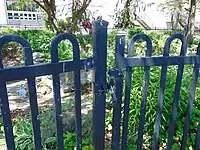Key:locked
 |
| Description |
|---|
| Used to mark a gate, barrier or other feature as locked or not. |
| Group: barriers |
| Used on these elements |
| See also |
|
| Status: approved |
| Tools for this tag |
|
access=* is used to describe the legal permission to travel through a barrier but does not indicate in emergencies what the physical access is.
For example it can be very important to know if a gate on a roadway is usually locked and hence can't be accessed easily without obtaining the key or unlocked and can easily be opened/closed.
How to map
=yesThe gate or barrier is usually locked and not accessible without the key.=noThe gate or barrier is usually unlocked and is accessible to anyone (may still need to manually open the gate).
A key does not need to be a traditional key, it could be a contactless card, swipe card, or a PIN code.
Conditional locks
locked:conditional=*To specify a condition different to the default locked value per Conditional restrictions. eg.locked:conditional=yes @ (sunset-sunrise)to say that the gate is locked at night, combined with=noto indicate usually unlocked during the day.- While there is some 3k+ usage of
opening_hours=*in combination with=*,locked:conditional=*is preferred due to its clear and non-conflicting meaning.
Examples
- A bicycle parking cage which requires a public transport card to open would be tagged
=yessince you need a "key" in this case the swipe card to get inside.=yesdoes not make any comment on how widespread or easily obtainable the key is, just that you need a key. - A
tourism=wilderness_hutfor which you first have to retrieve the key somewhere would be tagged=yes.
See also
barrier:personnel=*which applies to barriers which have personnel to restrict access.